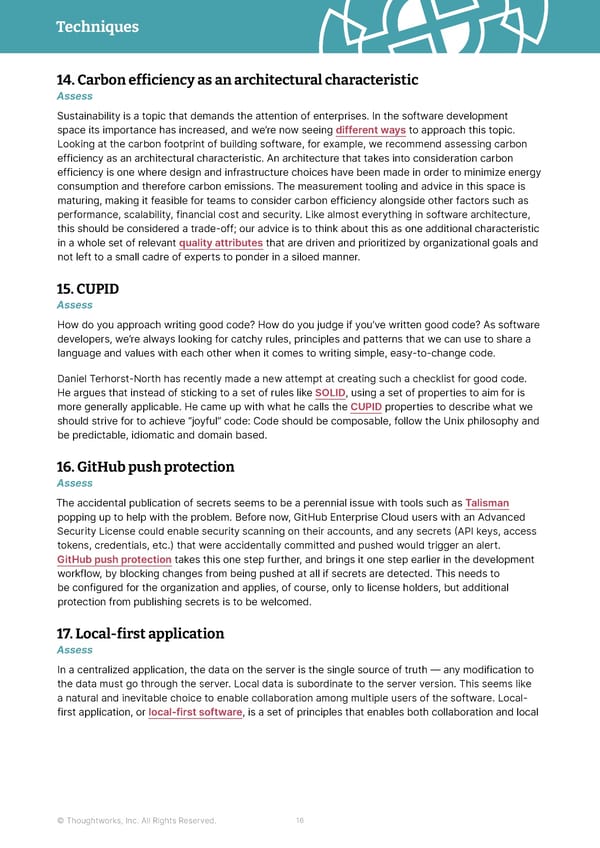Techniques Thoughtworks Technology Radar 14. Carbon efficiency as an architectural characteristic Assess Sustainability is a topic that demands the attention of enterprises. In the software development space its importance has increased, and we’re now seeing different ways to approach this topic. Looking at the carbon footprint of building software, for example, we recommend assessing carbon efficiency as an architectural characteristic. An architecture that takes into consideration carbon efficiency is one where design and infrastructure choices have been made in order to minimize energy consumption and therefore carbon emissions. The measurement tooling and advice in this space is maturing, making it feasible for teams to consider carbon efficiency alongside other factors such as performance, scalability, financial cost and security. Like almost everything in software architecture, this should be considered a trade-off; our advice is to think about this as one additional characteristic in a whole set of relevant quality attributes that are driven and prioritized by organizational goals and not left to a small cadre of experts to ponder in a siloed manner. 15. CUPID Assess How do you approach writing good code? How do you judge if you’ve written good code? As software developers, we’re always looking for catchy rules, principles and patterns that we can use to share a language and values with each other when it comes to writing simple, easy-to-change code. Daniel Terhorst-North has recently made a new attempt at creating such a checklist for good code. He argues that instead of sticking to a set of rules like SOLID, using a set of properties to aim for is more generally applicable. He came up with what he calls the CUPID properties to describe what we should strive for to achieve “joyful” code: Code should be composable, follow the Unix philosophy and be predictable, idiomatic and domain based. 16. GitHub push protection Assess The accidental publication of secrets seems to be a perennial issue with tools such as Talisman popping up to help with the problem. Before now, GitHub Enterprise Cloud users with an Advanced Security License could enable security scanning on their accounts, and any secrets (API keys, access tokens, credentials, etc.) that were accidentally committed and pushed would trigger an alert. GitHub push protection takes this one step further, and brings it one step earlier in the development workflow, by blocking changes from being pushed at all if secrets are detected. This needs to be configured for the organization and applies, of course, only to license holders, but additional protection from publishing secrets is to be welcomed. 17. Local-first application Assess In a centralized application, the data on the server is the single source of truth — any modification to the data must go through the server. Local data is subordinate to the server version. This seems like a natural and inevitable choice to enable collaboration among multiple users of the software. Local- first application, or local-first software, is a set of principles that enables both collaboration and local © Thoughtworks, Inc. All Rights Reserved. 16
 Vol 27 | Technology Radar Page 15 Page 17
Vol 27 | Technology Radar Page 15 Page 17